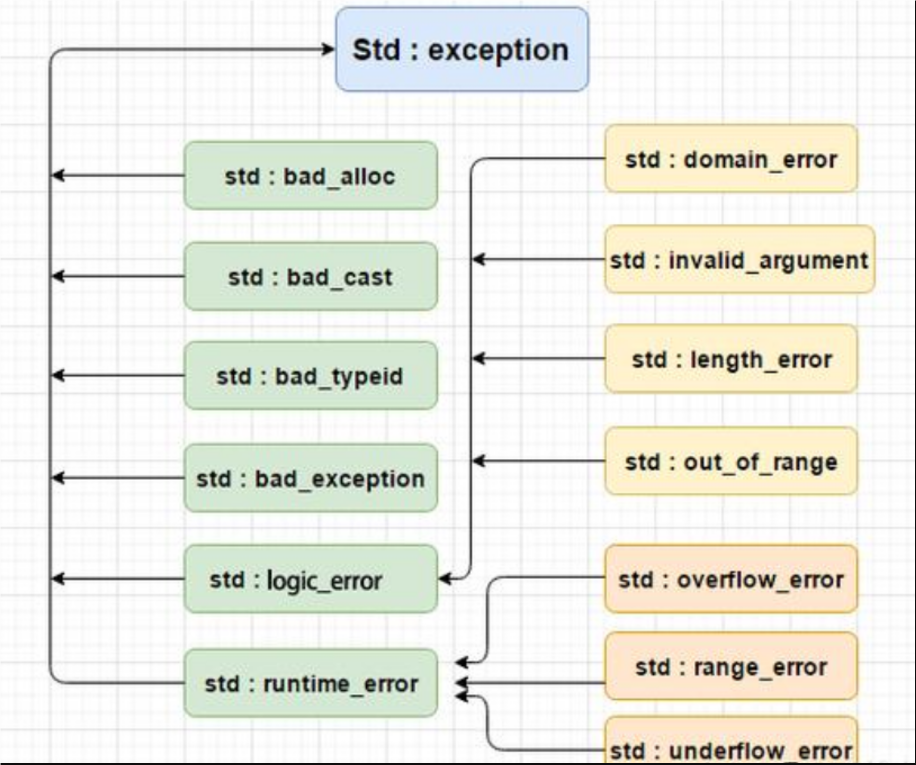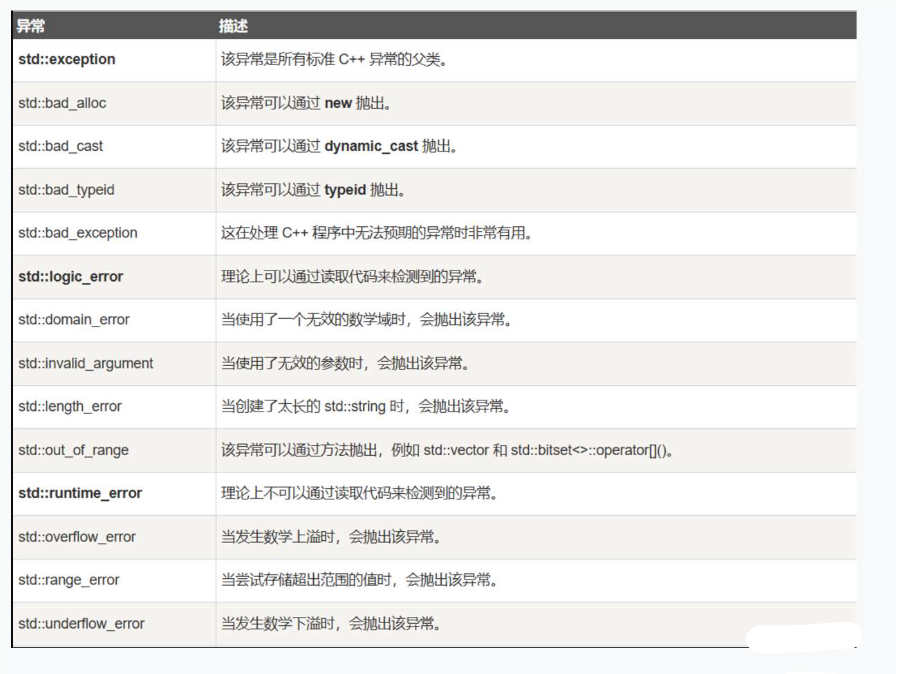1.异常概念
异常是一种处理错误的方式,当一个函数发现自己无法处理的错误时就会抛出异常,让函数的调用者处理这个错误
- throw:当出现问题时,程序会抛出一个异常,通过 throw 来完成
- catch:catch 关键字捕获异常,可以有多个 catch 捕获异常
如果有一个块抛出异常,捕获异常的方式会使用 try 和 catch 关键字。try 块中放置可能会抛出异常的代码,try 中的代码被称为保护代码
try
{// 保护的标识代码
}catch( ExceptionName e1 )
{// catch 块
}catch( ExceptionName e2 )
{// catch 块
}catch( ExceptionName eN )
{// catch 块
}2.异常的使用
异常的抛出和捕获
- 异常是通过抛出对象而引发的,该对象的类型决定了应该激活哪个catch的处理代码。
- 被选中的处理代码是调用链中与该对象类型匹配且离抛出异常位置最近的那一个。
- 抛出异常对象后,会生成一个异常对象的拷贝,因为抛出的异常对象可能是一个临时对象, 所以会生成一个拷贝对象,这个拷贝的临时对象会在被catch以后销毁。(这里的处理类似于函数的传值返回)
- catch(...)可以捕获任意类型的异常,问题是不知道异常错误是什么。
- 实际中抛出和捕获的匹配原则有个例外,并不都是类型完全匹配,可以抛出的派生类对象,使用基类捕获,这个在实际中非常实用。
在函数调用链中异常栈展开匹配原则
- 首先检查throw本身是否在try块内部,如果是,再查找匹配的catch语句。如果有匹配的,则调到catch的地方进行处理。
- 没有匹配的catch则退出当前函数栈,继续再调用函数的栈中进行查找匹配的catch。
- 如果到达main函数的栈,依旧没有匹配的,则终止程序。上述这个沿着调用链查找匹配的catch子句的过程称为栈展开。所以实际中我们最后都要加一个catch(...)捕获任意类型的异常,否则当有异常没捕获,程序就会直接终止。
- 找到匹配的catch子句并处理以后,会继续沿着catch子句后面继续执行。
#include <mutex>
#include <iostream>
using namespace std;double Division(int a, int b)
{// 当b == 0时抛出异常if (b == 0)throw "Division by zero condition!";elsereturn ((double)a / (double)b);
}
void Func()
{int len, time;cin >> len >> time;cout << Division(len, time) << endl;
}
int main()
{try {Func();}catch (const char* errmsg){cout << errmsg << endl;}catch (...) {cout << "unkown exception" << endl;}return 0;
}异常的重新抛出
有时候单个的 catch 不能完全处理一个异常,所以有了异常的重新抛出
#include <iostream>
#include <stdexcept>void mightGoWrong() {throw std::runtime_error("Something went wrong");
}void handleException() {try {mightGoWrong();} catch(const std::runtime_error& e) {std::cerr << "Caught an exception: " << e.what() << '\n';// 处理异常,但决定重新抛出throw; // 重新抛出当前捕获的异常}
}int main() {try {handleException();} catch(const std::runtime_error& e) {std::cerr << "Exception in main: " << e.what() << '\n';}return 0;
}异常安全
- 构造函数完成对象的构造和初始化,最好不要在构造函数中抛出异常,否则可能导致对象不完整或没有完全初始化。
- 析构函数主要完成资源的清理,最好不要在析构函数内抛出异常,否则可能导致资源泄漏(内存泄漏、句柄未关闭等)。
- C++中异常经常会导致资源泄漏的问题,比如在new和delete中抛出了异常,导致内存泄漏,在lock和unlock之间抛出了异常导致死锁,C++经常使用RAII来解决以上问题。
异常规范
- 异常规格说明的目的是为了让函数使用者知道该函数可能抛出的异常有哪些。 可以在函数的后面接throw(类型),列出这个函数可能抛掷的所有异常类型。
- 函数的后面接throw(),表示函数不抛异常。
- 若无异常接口声明,则此函数可以抛掷任何类型的异常。
// 这里表示这个函数会抛出A/B/C/D中的某种类型的异常
void fun() throw(A,B,C,D);
// 这里表示这个函数只会抛出bad_alloc的异常
void* operator new (std::size_t size) throw (std::bad_alloc);
// 这里表示这个函数不会抛出异常
void* operator delete (std::size_t size, void* ptr) throw();
// C++11 中新增的noexcept,表示不会抛异常
thread() noexcept;
thread (thread&& x) noexcept;3.自定义异常体系
一般情况下,抛出的异常都是派生类对象,异常捕获的是基类对象,派生类继承了基类,这样 catch 捕获的时候,只需要捕获基类对象就可以了
#include <mutex>
#include <iostream>
using namespace std;class Exception
{
public:Exception(const string& errmsg, int id):_errmsg(errmsg), _id(id){}virtual string what() const{return _errmsg;}protected:string _errmsg;int _id;
};class SqlException : public Exception
{
public:SqlException(const string& errmsg, int id, const string& sql = ""):Exception(errmsg, id), _sql(sql){}virtual string what() const{string str = "SqlException:";str += _errmsg;str += "->";str += _sql;return str;}private:const string _sql;
};class CacheException : public Exception
{
public:CacheException(const string& errmsg, int id):Exception(errmsg, id){}virtual string what() const{string str = "CacheException:";str += _errmsg;return str;}
};class HttpServerException : public Exception
{
public:HttpServerException(const string& errmsg, int id, const string& type):Exception(errmsg, id), _type(type){}virtual string what() const{string str = "HttpServerException:";str += _type;str += ":";str += _errmsg;return str;}private:const string _type;
};void SQLMgr()
{srand(time(0));if (rand() % 7 == 0){throw SqlException("权限不足", 100, "select * from name = '张三'");}else{cout << "执行Sql成功" << endl;}
}void CacheMgr()
{srand(time(0));if (rand() % 5 == 0){throw CacheException("权限不足", 100);}else if (rand() % 6 == 0){throw CacheException("数据不存在", 101);}else{cout << "Cache获取成功" << endl;}SQLMgr();
}void HttpServer()
{// ...srand(time(0));if (rand() % 3 == 0){throw HttpServerException("请求资源不存在", 100, "get");}else if (rand() % 4 == 0){throw HttpServerException("权限不足", 101, "post");}else{cout << "http调用成功" << endl;}CacheMgr();
}int main()
{while (1){this_thread::sleep_for(chrono::seconds(1));try {HttpServer();}catch (const Exception& e) // 这里捕获父类对象就可以{// 多态cout << e.what() << endl;}catch (...){cout << "Unkown Exception" << endl;}}return 0;
}4.C++标准库的异常体系
C++提供了一系列标准的异常

关于异常的说明




)



